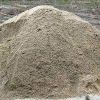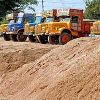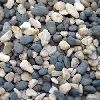








Aggregate
Get Price Quote
All aggregate is required to meet a minimum strength valve, as defined by the 10% value test. This and other specifications ensure that only the highest quality materials are being used on construction projects. Test Method: IS: 2386 (P-4)1963 Reaffirmed 2011 Alkali Aggregate Reactivity: Alkali-aggregate reaction is a term mainly referring to a reaction which occurs over time in concrete between the highly alkaline cement paste and non-crystalline silicon dioxide, which is found in many common aggregates. This reaction can cause expansion of the altered aggregate, leading to spalling and loss of strength of the concrete.Test Method: IS: 2386 (P-7) 1963 Reaffirmed 2011 Chloride Content: The total chloride content of aggregate is usually measured to assess whether the aggregate's contribution to the total chloride content of a concrete mix will be low enough to prevent the early onset of corrosion of any embedded steel reinforcement.Test Method: IS: 4032-1985 Reaffirmed 2009 Clay Lumps and friable Particles: This test helps in determining the percentage of clay lumps and friable particles in aggregate. Clay lumps in aggregate shall be defined as any particles or aggregation of particles which when thoroughly wet can be distorted when squeezed between the thumb and forefinger, or will disintegrate into individual grain sizes when immersed for a short period in water. Friable particles are defined as particles which vary from the basic aggregate particles in that they may either readily disintegrate under normal handling and mixing pressures imposed upon them by construction procedures, or break down after being incorporated into the work.Test Method: IS: 2386 (P-2) 1963 Reaffirmed 2011 Clay Slit and Dust passing/ Sieve: This test helps in determining the of a granular material. The size distribution is often of critical importance to the way the material performs in use. A sieve analysis can be performed on any type of non-organic or organic granular materials including sands, crushed rock, clays, granite, feldspars, coal and soil, a wide range of manufactured powders, grain and seeds, down to a minimum size depending on the exact method. Being such a simple technique of particle sizing, it is probably the most common.Test Method: IS: 2386 (P-2) 1963 Reaffirmed 2011 Compaction Fraction: This test helps in determining the compaction percentage of an aggregate when loose compared to the same aggregate compacted in a standard manner. It is useful in assessing an aggregate’s when placed loosely, for example, as a pipe surround material. Aggregate suitable for use as pipe bedding would display a low compaction fraction, indicating it reaches a state of near full compaction under loose placement. Crushing Value: The Aggregate Crushing Value offers a related measure of the resistance of an average to crushing under a compressive load that is gradually applied.Test Method: IS: 9376-1979, IS: 2386 (P-4)1963 (Reaffirmed 2010) Drying Shrinkage: Drying shrinkage is defined as the contracting of a hardened concrete mixture due to the loss of capillary water. This shrinkage causes an increase in tensile stress, which may lead to cracking, internal warping, and external deflection, before the concrete is subjected to any kind of loading. Flakiness and Elongation Index: Flakey is the term applied to aggregate or chippings that are flat and thin with respect to their length or width, Aggregate particles are said to be flakey when their thickness is less than 0.6 of their mean size. The flakiness index is found by expressing the weight of the flakey aggregate as a percentage of the aggregate tested.Test Method: IS: 2386 (P-1) 1963 Reaffirmed 2011 Impact Value: This test helps in determining the value which indicates the ability of an aggregate to resist crushing. The lower the figure the stronger the aggregate, i.e. the greater its ability to resist crushing.Test Method: IS: 2386 (P-4) 1963, Reaffirmed 2011, ASTMC 131-2006 Lightweight Pieces: This test helps in determining the approximate percentage of lightweight pieces in aggregate by means of sink-float separation in a heavy liquid of suitable specific gravity. This method may be used in identifying pourous aggregate particles in research activities or in petrographic analysis. Los Angle Abrasion: The Los Angeles (L.A.) abrasion test (Figure 1) is a common test method used to indicate aggregate toughness and abrasion characteristics. Aggregate abrasion characteristics are important because the constituent aggregate in HMA must resist crushing, degradation and disintegration in order to produce a high quality HMA.Test Method: IS: 2386 (P-4) 1963 Reaffirmed 2011 Organic Impurities Effect on Mortar Strength: This test helps in determining the rapid assessment of organic impurities by indicates their presence. Comparison is made between compressive strengths of mortar made with washed and unwashed fine aggregate.Test Method: ASTM C40 Organic Impurities: This test helps in determining the presence of organic compounds in fine aggregates to for use in cement mortar or concrete. The test provides a quick, relative measure to determine if further tests of the fine aggregate are necessary before approval for use.Test Method: IS: 2386 (P-2)1963 Reaffirmed 2011 Particle Size Distribution: This test helps in determining the percentile quantity of particles of known diameter within a sample. The specimen can be either passed through a set of standard sieves in its natural state, or if a significant amount of binding material is present, such as clay, then the sample can first be washed over a small aperture sieve to remove the binding material.Test Method: IS: 2386 (P-1) 1963 Reaffirmed 2011, ASTM C136-2006, IS: 383-1970 Sand Equivalent Value: The sand equivalent test is a rapid field test to show the relative proportions of fine dust or clay-like materials in fine aggregate (or granular soils).Test Method: MORTM, IS: 2720 (Pt-37)1976 Reaffirmed 2011, ASTM D 2419-2009 Soundness: This test helps in determining the resistance to disintegration by freezing and thawing. It furnishes information helpful in judging the soundness of aggregates subjected to weathering, particularly when adequate information is not available from service records of the behavior of the aggregate.Test Method: IS: 2386 (P-5)1963 Reaffirmed 2011 Specific gravity and water absorption: The specific gravity of an aggregate is considered to be a measure of strength or quality of the material. The specific gravity test helps in the identification of stone. Water absorption gives an idea of strength of aggregate. Aggregates having more water absorption are more porous in nature and are generally considered unsuitable unless they are found to be acceptable based on strength, impact and hardness tests.Test Method: IS: 2386 (P-3)1963 Reaffirmed 2011, ASTM C 127, 128-2007 Sulphate Content: The total sulphate content of aggregate is usually measured to assess whether the aggregate's contribution to the total sulphate content of a concrete mix will be low enough to prevent any deleterious effects.Test Method: IS: 4032-1985 Reaffirmed 2009

Sand
Get Price Quote
Sand, Earthmovers On Hire, Cranes On Hire, Mobile Cranes On Hire
Best Deals from Construction Aggregates

Sand
Get Price Quote
Sand

Sand
Get Price Quote
Sand

Calcite
Get Price Quote
Stone, Barytes, Talc, Feldspar, Metal Ores, Granite Slabs, tiles slabs